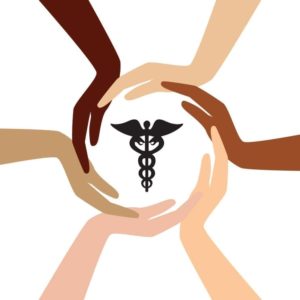This article was written by Laurel Whitis, D.O.’17, M.P.H.; Matthew Mueller, D.O.’17, M.P.H.’21; and Chelsea Thibodeau, D.O.’17.
As health care providers in training, we are responsible for learn-ing as much as possible about our future patients – from the fundamentals of human biology to the intricate ways in which each individual interacts with the world. Our education teaches us not just about disease processes, but also about the populations at greatest risk for developing these diseases. We are all familiar with the introductory bar graphs showing that minority populations are at higher risk of developing a disease, and once they do, they are more likely to die. But consider – how many times has the lecturer actually explained the factors contributing to this disparity? In our experience, never.
This is not due to poor teaching or ignorance, but due to the fact that we are profoundly uncomfortable with having a conversation about how we are failing to provide quality health care to the 37.7 percent of our country that identifies as a race or ethnicity other than white and non- Hispanic (U.S. Census, 2013).
SOME FACTS:
• African Americans are less likely to receive medication, angiography and cardiac catheterization than white Americans with the same diagnosis and symptoms (Mayberry et al., 2000).
• Physicians spend less time planning and collaborating with patients of minority racial and ethnic groups (Benkert and Peters, 2005).
• Patients of color are less likely to have their level of pain recorded accurately and receive adequate pain management than white Americans (Cintron et al., 2006).
• White physicians are more likely to assume that black women lack the motivation or income necessary to follow specific medication regimens (Ginty, 2005).
Many of us respond to these important facts with “That’s horrible, but I’m not racist, so there is no way I would deliver inferior care to people of color.” However, having good, compassionate intentions does not override the subconscious biases deeply ingrained in many of us and within the medical community as a whole. A study published in 2009 examined physicians’ unconscious bias with the implicit association test (IAT), in which participants matched faces of people to positive or negative traits. The researchers found that white physicians were more likely to match white faces to positive traits and minority faces to negative traits (Sabin, 2009). Physicians who scored highly on the IAT (associating more minority faces with negative traits) were less likely to prescribe adequate pain medication to black patients (Sabin, 2012). These physicians all denied being racist, but the color of their patients’ skin directly impacted the quality of care they delivered.
If we fail to act now, we perpetuate the problem. Our health care system is failing to provide quality care for minority patients. In just a few years, we are going to be a part of that very system – a system in which people, whose health is often already at a disadvantage due to nationwide systemic racism, are given inferior care.
As future health care providers, we must acknowledge our inherent racial biases or we risk harming the very people we strive to serve. It is our duty as responsible citizens and future health care providers to increase our understanding of the health disparities that exist in our society. We mustn’t learn only the statistics presented at the beginning of class; we must strive to truly understand why those disparities exist. This knowledge will equip us to face the systemic racism that exists in health care and society.
We will be prepared to have honest, open and educated conversations about these difficult topics. It’s imperative that we all evaluate ourselves before we can effectively evaluate this crisis in health care. We need to have open conversations about these problems and not hide behind a façade of “I’m not racist; this has nothing to do with me.” Our oath to do no harm has no exception clause – the time to act is now.
In December 2014, Laurel Whitis, D.O.’17, M.P.H.; Matthew Mueller, D.O.’17, M.P.H.’21; and Chelsea Thibodeau, D.O.’17, were among the students who took part in the “White Coats for Black Lives” movement, in which medical students, faculty and staff at more than 80 medical schools and institutions nationwide staged “die-ins” to peacefully protest the injustice of racial disparities in health care. They then shared this essay with the DMU campus community via e-mail to provide basic information on the issue of systemic racial inequality in medicine. “Our goal was to prompt further thought, conversation and inquiry among the DMU community,” they said. “Ultimately, our hope is that this essay served to facilitate introspection and discussion on race, bias and health care inequalities.”


